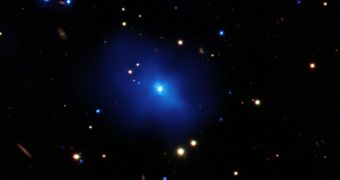In their investigations of a very distant galactic cluster, astronomers managed to determine that an impressive quasar lies at the very core of the structure, surrounded by a bright envelope of relatively cool gas.
The quasi-stellar radio source (quasar) is called 3C 186, and it was discovered using the American space agency's Chandra X-ray Observatory. Quasars are the most luminous objects in the Universe.
These energetic and distant galaxies have a very active galactic nucleus, and are considered to be high redshift sources of electromagnetic energy, such as for example visible light and radio wavelengths.
The recently found object has been discovered very far away from Earth, and experts are convinced that it could be used to gain a new perspective of how quasars' development is triggered.
Experts also want to know whether there is any connection between this phenomenon and the growth of galaxy clusters, which have been found permeating the Universe, Space Fellowship reports.
The new Chandra study of 3C 186 was authored by Harvard-Smithsonian Center for Astrophysics (CfA) experts Aneta Siemiginowska, Douglas Burke and Thomas Aldcroft, in collaboration with an international team of researchers,
Scientists from the University of Bristol, the Kavli Institute for Particle Astrophysics and Cosmology, the University of Arizona and the Naval Research Laboratory (NRL) were also involved in the work.
Details of the galactic cluster and its central quasar were published in the October 10 issue of the esteemed Astrophysical Journal. The team worked with a deep, composite image that Chandra snapped.
Using spectral readings collected with the NASA telescope, the team managed to determine that the temperature of the gas envelope surrounding the cluster dropped considerably from its edges to its core.
At the exterior, the gas reached 80 million degrees, whereas the core was several times cooler, at about 30 million degrees. X-ray emissions from the gas around the quasar are believed to be responsible for the cooling.
The new data also suggests that the 3c 186 quasar and its galactic cluster are extremely distant. Their age has recently been calculated to be 8 billion years old, which means that they have been around for more than half the life span of the Universe.
Additionally, scientists showed that this is the most distant quasar ever discovered. Galactic clusters have been found to exist farther away than 8 billion light-years, but none had an active galaxy within.

 14 DAY TRIAL //
14 DAY TRIAL //